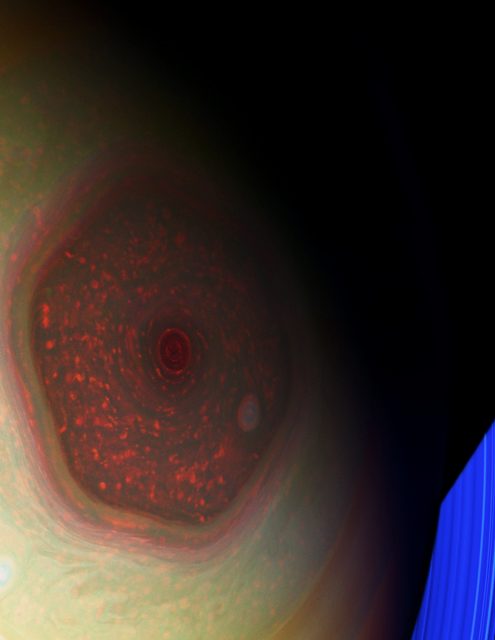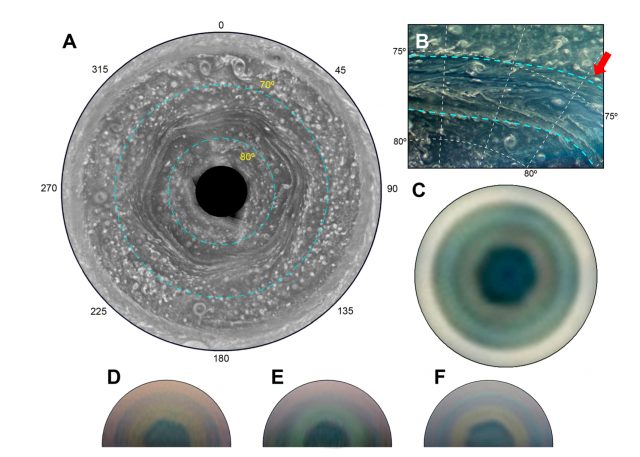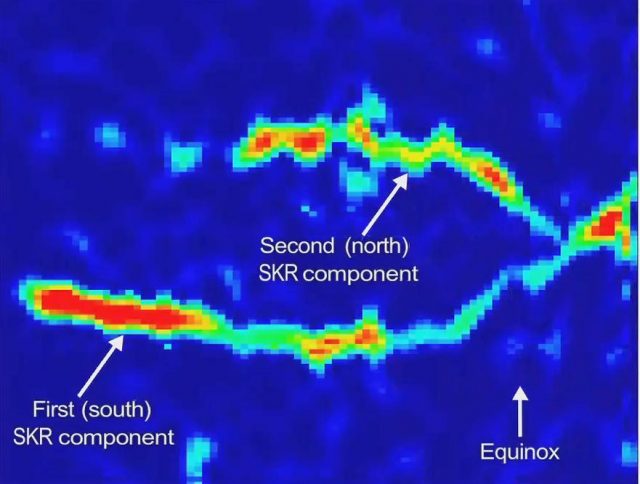The mysterious case of the Hexagon and Saturn’s rotation period

Can you name a polygonal feature in any of the Solar System atmospheres? None? Up to our current knowledge there is only one: Saturn’s Hexagon. Not only it is the one and only of its kind but it is also the longest-lived planetary-scale atmospheric feature in any planet. A recent paper by Agustín Sánchez-Lavega and collaborators, including the author of these lines, has just showed that the motion of this structure is remarkably stable and resembles the disputed internal rotation period of the planet 1.
Let’s go back to the eighties for a moment. This is roughly a Saturn’s year, which takes some 30 years to complete a turn around the Sun. During the Voyager 1 and 2 flybys it was possible to see for the first time the Hexagon, enclosing the planet’s north pole 2. This was later observed again using Hubble Space Telescope and ground-based telescopes in the nineties. Some interpretations were proposed to explain how it was possible to sustain such a strange feature. In general it was accepted that it is wavy phenomenon forced for some reason to acquire the hexagonal shape 3. The wave was enclosed by a strong jet reaching almost 400 km/h, at those times, it was thought that the interaction of such a strong jet stream and a large anticyclone that was then present was the cause for the surprising polygonal shape.
By 2008, given Saturn’s rotation axis tilt, it was possible to observe the Hexagon again after a long winter night in the planet’s pole. There it was. The work by Sánchez-Lavega et al. analyzes the movement of the Hexagon vertices for 6 years (2008-2014) and compares it with the movement measured at 1980-81 and 1990-91. And this movement turned out to be surprisingly steady and regular over one Saturn’s year. The work also used observations from ground-based observatories including images obtained at Calar Alto observatory in Almeria (Spain) now under serious threats due to sever budget cut-offs.

The long temporal base-line acquired with Cassini observations makes it possible to trace the movement of the hexagon’s vertices with great accuracy. The Cassini epoch observations that the hexagon is present regardless of the absence of the vortex that was formerly thought to be the ultimate case of the shape. This requires new models explaining the formation and sustainability of the structure. One possible cause, as pointed out by Sánchez-Lavega, is a Rossby wave, an atmospheric wave forced by the variation of the Coriolis force with latitude. This kind of model, in the presence of the strong meridional shear caused by the aforementioned jet stream qualitatively agrees with our observations but new and more detailed dynamical models are required.
There is still one more aspect that the Hexagon comes to enlighten. As reviewed in 2005 by Agustín Sánchez-Lavega 4, we do not know yet how fast Saturn’s interior spins. This is commonly determined by radio emissions forced by the rotation of the planetary core. However, Ulysses spacecraft measurements, first, and Cassini, later, showed that radio emissions were much more difficult to understand than that. We now know that the kilometric radiation oscillates with two different periods differing in 15 minutes and thus they give no precise indication on the rotation of the planet5.

However, it is the case that the Hexagon rotates constantly once every 10h 39m 23s and it has changed only by 3.5s since the Voyager era. This is surprisingly similar to the so called System III established by Voyager radio measurements. It was first proposed by D. A. Godfrey that the Hexagon could be a manifestation of the deep rotation of the planet, even though we only see the upper manifestation of the structure. Now, the results by this recent work support the idea and, at the very least, provides a trustworthy reference in Saturn for determining a reference frame evenly rotating for more than a Saturn’s year.
All in all, it turns out that an atmospheric feature could be the best testimony of the deep interior of the planet. There are basically two reasons that support the Hexagon being a deeply rooted feature. First, it survived a long polar night, under strong insolation changes not very different to those inside the Earth’s arctics. Secondly, the extremely stable rotation of the wave demonstrates a huge inertia that probably requires an amount of mass larger that what we can see in the upper atmosphere. There are still a good number of unknowns that require exploration in this mysterious case. In particular, there is no dynamical model yet able to explain the origin and stability of the Hexagon. If we had that, we could investigate how the Hexagon’s rotation is related to the rotation of the planet itself. There is surely a lot of science yet to come and exciting times for the people reproducing fluid mechanics in the computer.
References
- Sánchez-Lavega A., del Río-Gaztelurrutia T., Hueso R., Pérez-Hoyos S., García-Melendo E., Antuñano A., Mendikoa I., Rojas J.F., Lillo J. & Barrado-Navascués D. & (2014). The long-term steady motion of Saturn’s hexagon and the stability of its enclosed jet stream under seasonal changes, Geophysical Research Letters, 41 (5) 1425-1431. DOI: 10.1002/2013GL059078 ↩
- D.A. Godfrey (1988). A hexagonal feature around Saturn’s north pole. Icarus 76, 335 – 356. doi: 10.1016/0019-1035(88)90075-9 ↩
- Allison, M., D. A. Godfrey, and R. F. Beebe (1990). A wave dynamical interpretation of Saturn’s Polar Hexagon. Science, 247, 1061–1063. doi:10.1126/science.247.4946.1061. ↩
- A. Sánchez-Lavega (2005). How long is the day in Saturn? Science 307, 1223-1224. doi: 10.1126/science.1104956 ↩
- D.A. Gurnett et al. (2010). The reversal of the rotational modulation rates of the north and south components of Saturn kilometric radiation near equinox, Geophys. Res. Lett., 37, L24101, doi:10.1029/2010GL045796 ↩
3 comments
[…] estable durante al menos un año del planeta para determinar un sistema de referencia. En esta entrada de Mapping Ignorance discuto en detalle las implicaciones de este trabajo en el contexto de nuestro conocimiento […]
[…] sus misterios, nos cuenta lo último sobre la rotación del hexágono…y la del planeta en The mysterious case of the Hexagon and Saturn’s rotation period. Por cierto, que Santi es muy modesto y no quiere que lo diga, pero […]
[…] The mysterious case of the Hexagon and Saturn’s rotation period […]